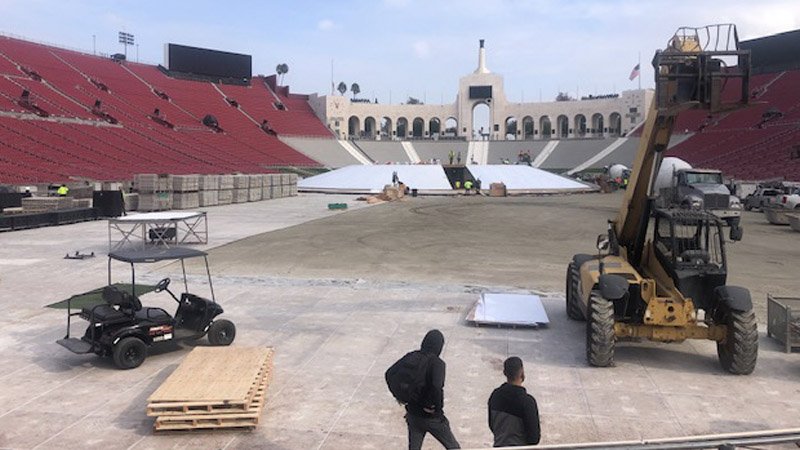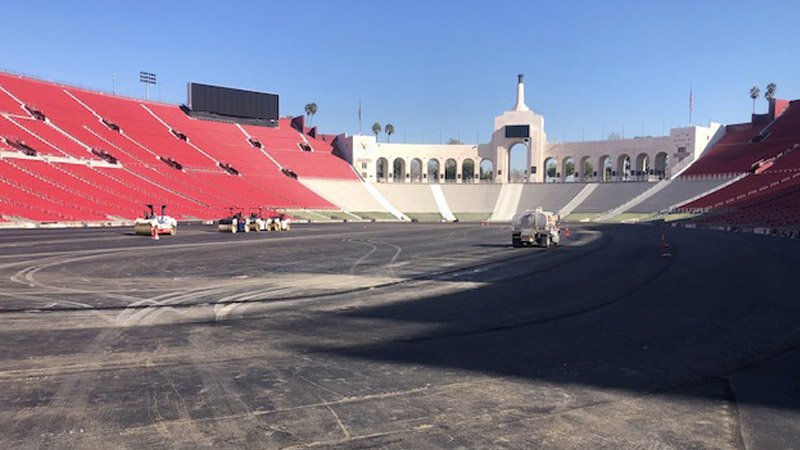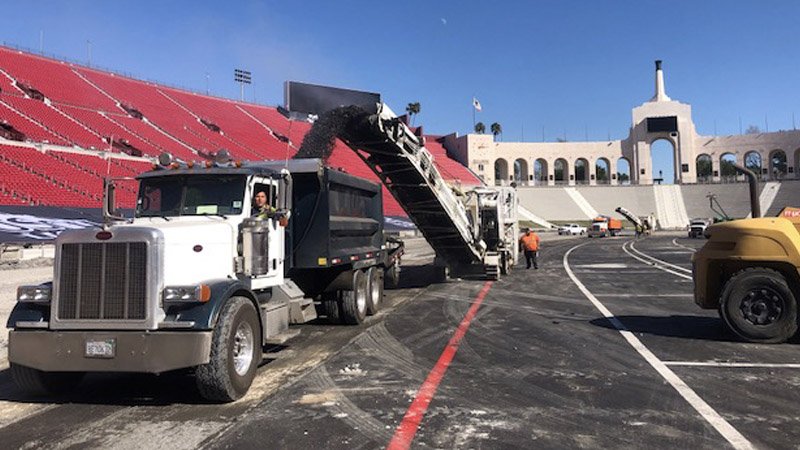
As the sports field manager at one of the nation's most iconic stadiums, Scott Lupold is no stranger to big events, but he is in the middle of an experience few have faced before.
Lupold, in his fifth season as the turf manager at Los Angeles Memorial Coliseum, is fresh off hosting a concert and car race and is now on the clock as he and his team shift their focus to installing a new field in advance of the next big sporting event. Think of it as going from no grass to a member-guest in five days.
Adjacent to the University of Southern California and steps away from downtown Los Angeles, the 100-year-old LA Coliseum has a peerless history. The first Super Bowl was held there in 1967, and it is where the Miami Dolphins capped the only undefeated season in NFL history in Super Bowl VII in 1973.
It's always busy here, and there is not much down time to cultivate the field into the ideal playing surface.
The stadium has been the home of USC football since it opened in 1923, and the LA Rams, Chargers and Raiders also played home games there. The NFL's Pro Bowl was played there from 1950 to 1971, and the Dodgers played there for three years after moving west from Brooklyn in 1958, including the 1959 World Series. A burning torch atop the iconic peristyle plaza and Olympic rings on the facade serve as a reminder that the stadium was the site of the 1932 games.
When one team or another is not playing there, the stadium is a popular concert venue and many movies and commercials were shot there.
Lupold, however, has never had an experience like the one that recently took place at the stadium in recent weeks.
The grass at the Coliseum, which by the way was built for less than $1 million in 1923, has been undercover for more than eight weeks. Immediately after a concert by the artist formerly known as Kanye on Dec. 9, NASCAR moved in to begin preparations for this year's Busch Light Clash at the Coliseum, an exhibition race that helped kick off the stock car racing season. Although the race, formerly held in Daytona Beach, and its unique format helped NASCAR reach out to new audiences, it represented unique challenges for Lupold.

After NASCAR, which spent more than $1 million to build a temporary asphalt track it already has begun to remove, clears out of the Coliseum by Feb. 19, Lupold will begin regrassing the field with with 85,000 square feet of Tahoma 31 Bermudagrass through West Coast Turf's Palm Desert facility.
"The grass is toast," said Lupold. "The concert and the race were scheduled around the idea of this being resodded. That gave NASCAR a head start on getting everything ready."
Once NASCAR packs up and leaves by Feb. 19, Lupold will have five days to till and laser grade the surface, roll out sod and get ready for the stadium's newest client, the LA Giltinis professional rugby team that is scheduled to practice at the Coliseum on Feb. 25 and host a game the following day.
The grass is toast. The concert and the race were scheduled around the idea of this being resodded.
When that team hits the field, they will be playing on a new turf cultivar that will make its debut at the Coliseum.
After experimenting with several varieties of Bermudagrass in recent years, such as Bandera, Tifway 419 and TifSport, Lupold settled this year on Tahoma 31 after testing it last season on USC's nearby practice field.
"What I was impressed with were the number of individual plants," Lupold said. "So many other varieties push stolons, this pushes leaf more than stolons. It likes to leaf and stay vertical."
That makes it much easier to manage, and it also will help improve playability during the upcoming USC season under new head coach Lincoln Riley.

"I run grooming reels on it and verticut some, and it never gets out of control," he said.
"Because there are so many more plants, when players cut and take out turf, we won't lose as much turf because it is not all connected."
Long before he could think about resodding, Lupold was more concerned about what was going on under the surface as crews came on site to get the Coliseum for a concert and then a car race.
Truckloads of dirt were brought as a base beneath the floor installed for the concert. Afterward, the dirt was left and NASCAR trucked in even more, raising the surface of the field a minimum of a foot-and-a-half and up to 4 feet in the banked turns and on top of that installed an asphalt track. Layers of plastic, a fibrous cover and plywood between the dirt and areas of artificial turf along the sidelines and warning track to prevent the synthetic surface from being contaminated by unwanted organic matter.
"They'd just dump it, dump it, dump it, dump it, push it around and go get more," Lupold said.
"My concerns were contamination, and protecting the irrigation system and the drainage tiles under the weight of all that dirt and all the cars. It was a lot of dirt."
What I was impressed with were the number of individual plants.
When Lupold gets the field back from NASCAR on Feb. 19, he and his team will remove the existing surface matter the old-fashioned way - with sod cutters - and eventually will roll out Tahoma sod grown to 1.25 inches. Where the mowing height goes from there - other than down - is unclear for now thanks to a schedule that includes football, rugby, international soccer games and probably a few more events that are not yet on the schedule. There also is a concert on the books for September that will require once again removing the old field and installing a new one.
"That's the million-dollar question. We don't know yet," Lupold said. "There is a ton of leaf blade at three-eighths. I'd like to live between three-eighths and seven-sixteenths. That is in our wheelhouse, but by the end of football season, you're in survival mode and you go where the grass takes you.
"It's always busy here, and there is not much down time to cultivate the field into the ideal playing surface. We are looking for more of a maintenance than we are selling out to a playing surface."
For now, anyway.

